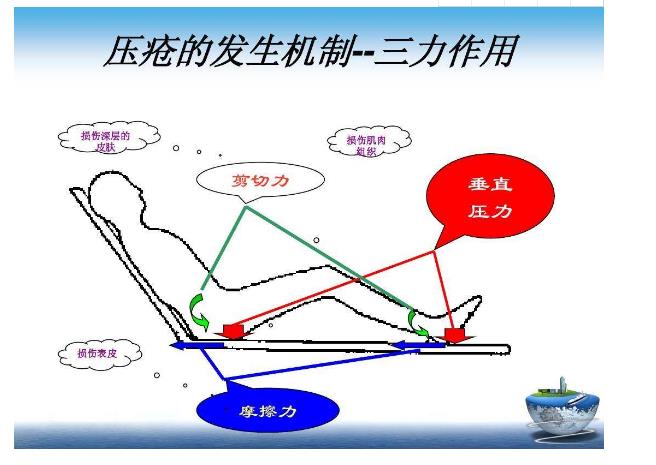中文摘要
某医院270例住院压疮患者病例分析
目的
本研究旨在通过收集某医院2015年9月至2017年4月270例压疮患者的临床病例信息,整理归纳并分析某医院压疮患者的一般人口学资料与临床资料,计算某医院获得性压疮的发生率,比较分析院外带入性压疮和医院获得性压疮的一般人口学特征、临床特征,并根据分析结果,制定压疮的预防和护理措施,降低某院临床护理中医院获得性压疮的发生率,提高压疮的护理水平。

方法
本次研究对某医院2015年9月一2017年4月收治的270例压疮患者进行调查分析,调查内容为压疮患者的一般人口学特征和临床特征,一般人口学资料包括压疮患者的性别、年龄、职业、文化程度和婚姻状况。临床资料包括入院时间、所在科室、压疮发生的时间、压疮部位、是否伴有感染、家族史、过敏史、饮酒史、吸烟史、手术、自理情况、慢性病、水肿,血压和血管活性药物。将270例压疮患者调查的全部资料录入Excel表格建立数据库,分析压疮患者的一般人口学特征和临床特征的构成比以及压疮多发部位、多发季节、多发时间、多发科室等相关因素的构成比,计算某医院获得性压疮的发生率。采用SPSS21.0软件对院外带入性压疮和医院获得性压疮患者的一般人口学特征及临床特征、多发科室、多发部位、多发季节、多发时间进行比较,采用卡方检验和Fisher确切概率法进行统计分析。
结果
某医院2015年9月一2017年4月期间医院获得性压疮的发生率为0.090% o270例压疮患者中,住院时间(4-24天,平均年龄为(69.94士0.94岁,大于60岁的患者居多,占69.63,性别差异不大,初中、中专学历和丧偶的患者居多,分别占52.59%和48.52%,患者多以工人和退休人员为主,分别占42.22%和27.41;多数具有过敏史(73.70% )、无家族史(94.44% )、不能自理(67.78% ),有吸烟史(79.26% )、有饮酒史(79.63% )、有慢性病(78.15% )、进行过手术治疗(82.59% )、感染(96.67% )、血压偏低(72.22% )、使用血管活性药物(71.48% )、不可分期压疮较多(36.67% )。神经内科和骨外科压疮患者占比较高,分别占34.07%和28.52%.压疮的多发部位在患者的臀部和骼尾部,分别占45.12%和16.89%.冬天和春天是容易发生压疮的季节,分别占34.07%,30.00%.压疮多发生在凌晨的2:00-8:00,占16.67%.院外带入性压疮和医院获得性压疮在一般人口学特征方面(不包括文化程度)、家族史、吸烟史、饮酒史、自理能力、慢性病、科室分布、发病季节和发生时间等方面差异无统计学意义。院外带入性压疮和医院获得性压疮在文化程度、压疮分期和压疮的多发部位方面差异有统计学意义(P<0.05.
结论
本研究对某医院270例压疮患者从一般人口学资料和临床资料两方面进行分析,得出以下结论:
(1)某医院获得性压疮的发生率为0.090% o.
(2)从一般人口学特征方面看,性别在压疮患者中差异不大,压疮患者年龄多集中在老年人(61周岁以上),初中、中专学历和丧偶居多,患者多以工人和退体人员为主。
(3)从临床特征方面看,压疮患者多有过敏史、无家族史、不能自理、有吸烟史、有饮酒史、有慢性病、进行过手术治疗、感染,使用血管活性药。
(4)压疮患者在神经内科、骨外科比较多;多发部位在患者的臀部、骨氏尾部;冬天和春天是容易发生压疮的季节;压疮多发生在凌晨2:00-8:OOo.
(5)院外带入性压疮和医院获得性压疮在文化程度、压疮分期和压疮的多发部位方面差异有统计学意义。
关键词:压疮,现状,调查,分析
Abstract
Case analysis of 270 hospitalized patients with pressure ulcersin a certain hospitalObjective.
The purpose of this study is to collect the clinical information of 270 hospitalizedpatients with pressure ulcers from September 2015 to April 2017 in a certain hospital,and analyze general demographic information and clinical characteristics, calculate theincidence rate of hospital-acquired pressure ulcer (HAPU), and compare withgeneral demographic information and clinical characteristics between HAPU andpressure ulcers outside hospital (PUOH), in order to take preventive and nursingmeasures, reduce the incidence rate of HAPU, improve the care level of pressureulcers.
MethodsThe data of 270 hospitalized patients with pressure ulcers were collected andanalyzed from September 2015 to April 2017 in a certain hospital. Investigation dataincluded general demographic information and clinical characteristics data. Thegeneral demographic information included sex, age, occupation, culture and marriageof pressure ulcers patients. Clinic data included admission time, the departments,pressure ulcer time and locations, with or without infection, family history, allergichistory, drinking history, smoking history, operation, self-care situation, chronicdiseases, edema, pressure and vasoactive agent. All the data of 270 patients were inputinto Excel table to establish database. The constituent ratios of the generaldemographic information, clicnic characteristics and pressure ulcers location,occurrence seasons and time, departments were analyzed. The incidence rate ofHAPU was calculated. The comparation of the general demographic information,clicnic characteristics, departments, locations, occurrence seasons and time of ulcerpressure between PUOH and HAPU were performed,which were analyzed withchi-square test and Fisher exact probability.
ResultsDuring September 2015 to April 2017 in the hospital, the incidence rate ofHAPU was 0.090%. Among the 270 patients with pressure ulcer, hospital stay was(4-24) days, mean age was (69.94士0.94) years. The most patients were over 60 yearold (69.63%), no significant difference in sex, middle school and technical secondaryschool education (52.59%) and widowed (48.52%), workers (42.22%) and retirees(27.41%), most of whom had allergic history (73.70%)、without family history(94.44%), no self-care ability (67.78%), history of smoking (79.26%), the history ofdrinking (79.63%), chronic diseases (78.15%), surgical treatment (82.59%),infection(96.67%), low pressure (72.22%), using vasoactive agent (71.48%) and unstageable(36.67%)。 The constituent ratios of patients with pressure ulcer in neurology and bonesurgery were the most,which were 34.07% and 28.52%, respectively. The most ofpressure ulcer parts in patients were hips and sacrococcygeal, the constituent ratios ofwhich were 45.12% and 16.89%, respectively. Winter and spring were prone topressure ulcers occurrence, the constituent ratios of which were 34.07% and 30.00%.
Pressure ulcer often occurred at 2: 00-8: 00 AM, the constituent ratio of which were16.67%. There were no significant difference among the general demographicinformation (except for culture level), the history of family, smoking, drinking,self-care ability, chronic diseases, the departments, occurrence seasons and timebetween HAPU and PUOH. There were significant differences among culture level,pressure ulcers stages and locations between HAPU and PUOH (P<0.05)。
ConclusionsThis study analyzed general demographic information and clinic data among 270patients with pressure ulcers in a certain hospital, conclusions were drawn:
(1) The incidence rate of HAPU was 0.090%.
(2) In terms of general demographic information, pressure ulcer patients had nosignificant difference in sex. The pressure ulcers were more concentrated in theelderly (above 61 years of age), middle school and technical secondary schooleducation and widowed, workers and retirees.
(3) Based on the clinical characteristics, most of the pressure ulcer patients hadallergic history, without family history, no self-care ability, smoking history, thedrinking history, chronic diseases, surgical treatment, infection and using vasoactiveagent.
(4) Most pressure ulcers patients were in neurology, bone surgery department.
Most pressure ulcers occurred at sacrococcygeal and hip, 2: 00-8: 00 AM, winter andspring.
(5) There were significant differences among culture level, pressure ulcers stagesand locations between HAPU and PUOH.
Keywords:Pressure ulcers, Current status, Investigation, Analysis.
目录
第1章综述
1.1压疮
1.2压疮形成病因
1.2.1压力因素
1.2.2营养状况
1.2.3皮肤免疫力降低
1.3临床分期·
1.4诊断与治疗
1.5护理干预
1.6国内外压疮研究状况与发展趋势
1.6.1国内外压疮发生情况的研究状况与发展趋势
1.6.2国内外院外带入性压疮和医院获得性压疮的研究状况
第2章资料与方法
2.1研究对象
纳入标准
排除标准
2.2资料的收集与整理
2.2.1纳入表内容:
2.3资料的整理
2.4统计学分析方法
2.5相关因素的界定
第3章结果
3.1医院获得性压疮的发生率情况
3.2压疮患者的一般人口学特征
3.3压疮患者的临床特征
3.4压疮患者的科室分布特征
3.5压疮发生部位分布特征
3.6压疮发生季节特征
3.7压疮发生时间段分布
3.8院外带入性压疮和医院获得性压疮的比较分析。
3.8.1院外带入性压疮和医院获得性压疮患者一般人口学特征。
3.8.2院外带入性压疮和医院获得性压疮患者临床特征
3.8.3院外带入性压疮和医院获得性压疮患者的科室分布特征
3.8.4院外带入性压疮和医院获得性压疮患者的压疮发生部位J清况
3.8.5院外带入性压疮和医院获得性压疮不同季节的分布情况
3.8.6院外带入性压疮和医院获得性压疮发生时间的分布
第4章讨论
4.1医院获得性压疮的发生率情况
4.2压疮患者的一般人口学特征
4.3压疮患者的临床特征
4.4压疮患者的科室分布和压疮发生部位
4.5压疮发生季节和发生时间段
4.6院外带入性压疮和医院获得性压疮的比较分析
4.7护理建议
第5章结论
参考文献
附录
作者简历及在学期间所取得的科研成果
致谢





